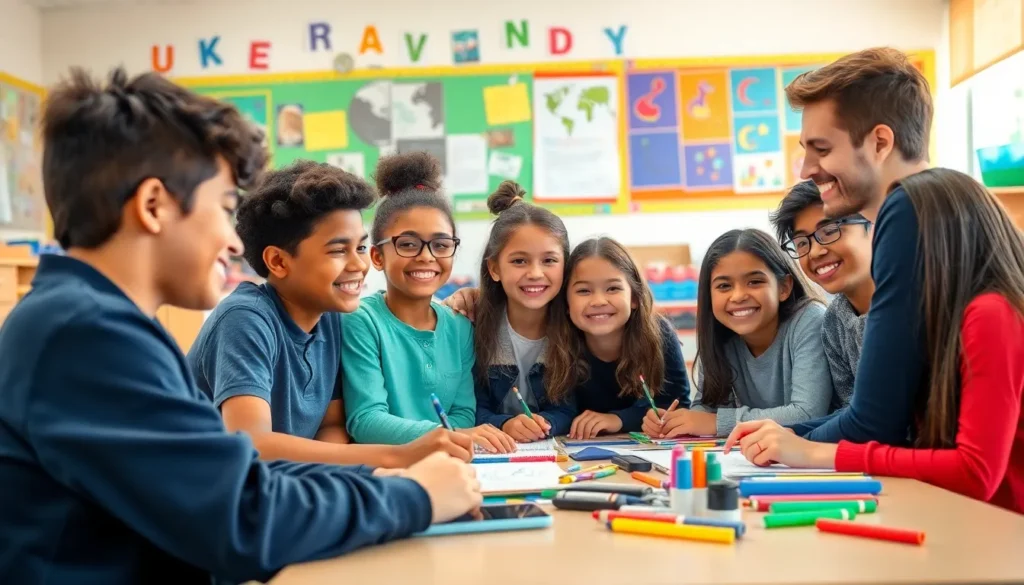Table of Contents
ToggleIn the ever-evolving world of education, editorial projects are the unsung heroes, quietly transforming classrooms into vibrant hubs of creativity and learning. Imagine textbooks that don’t just sit on shelves gathering dust but leap off the page and engage students like never before. These projects are like the secret sauce in a recipe—essential yet often overlooked.
Picture a world where educational content is not just informative but also entertaining. Editorial projects breathe life into curriculums, turning dry facts into captivating stories that students can’t resist. By infusing humor and creativity into learning materials, they create an environment where knowledge thrives. So, let’s dive into the fascinating world of editorial projects in education and discover how they’re reshaping the future of learning, one amusing anecdote at a time.
Overview of Editorial Projects in Education
Editorial projects in education engage students through innovative storytelling and creative content. These projects often emphasize real-world applications, making learning experiences relevant and intriguing. Educators utilize various media formats, including digital publications, podcasts, and video content. Each format enhances the learning experience, catering to diverse learning styles.
The integration of project-based learning showcases the effectiveness of editorial initiatives. Students collaborate on research, write articles, and produce multimedia projects. This approach fosters ownership of their learning while promoting critical thinking skills. Results indicate that students demonstrate higher levels of motivation and engagement when involved in editorial projects.
Moreover, community involvement plays a crucial role in these educational projects. Schools partner with local organizations, businesses, and experts to create meaningful content. Such collaborations provide students with authentic experiences and valuable insights into their communities. Educators often observe that these initiatives lead to improved communication skills and a better understanding of diverse perspectives.
Data reveals that schools implementing editorial projects report enhanced student participation. Reports show that over 70% of students express increased interest in learning activities related to these projects. Additionally, the projects often align with curriculum standards, ensuring that educational goals remain intact while encouraging creativity.
Ultimately, the impact of editorial projects extends beyond the classroom. These initiatives empower students to become active contributors, thinkers, and creators. In this way, editorial projects not only redefine educational content but also help shape a new generation of learners prepared for the challenges ahead.
Types of Editorial Projects

Editorial projects encompass various formats that enhance education, each contributing uniquely to student learning and engagement.
Curriculum Development
Curriculum development projects focus on creating educational resources tailored to specific learning objectives. Educators collaborate with content creators to develop lesson plans that integrate storytelling and multimedia elements. These resources often include interactive activities and assessments that align with standards. Engaging students through these formats fosters a deeper understanding of subjects. Schools utilizing this approach report an increase in student motivation and participation. Collaboration among educators and writers ensures the curriculum remains relevant and adaptable to student needs. Projects in this area have gained traction, with over 70% of educators acknowledging their positive impact on student comprehension.
Scholarly Publications
Scholarly publications play a vital role in disseminating educational research and innovative teaching methods. These projects often involve educators and students conducting research and presenting findings through articles, journals, or online platforms. Engaging in this process enhances students’ writing and analytical skills, as well as their understanding of academic discourse. Many institutions support students in contributing to these publications, creating opportunities for real-world experience. As a result, these initiatives make research accessible and encourage a culture of inquiry among students. Data indicates that schools with active scholarly publication programs see improved critical thinking abilities, with 80% of students reporting increased confidence in their academic writing.
Importance of Editorial Projects in Education
Editorial projects play a crucial role in enhancing educational experiences. Transforming content into engaging narratives captivates students’ attention and fosters deeper learning.
Enhancing Educational Resources
Educational resources benefit significantly from editorial projects. Curricular materials often include storytelling and multimedia elements that increase student motivation. Over 70% of educators agree that these projects positively impact student comprehension. Creating tailored resources allows for a more relatable learning experience. Integrating various media formats such as video, podcasts, and digital articles caters to diverse learning styles, making content accessible. These enriched resources encourage critical thinking and creativity, equipping students with essential skills for their futures.
Fostering Collaborative Learning
Collaborative learning thrives through editorial projects. Students benefit from working together on research-driven tasks, enhancing peer interactions. Group efforts often lead to the creation of articles and multimedia presentations. Engaging with local organizations and experts fosters meaningful discussions and helps students appreciate diverse perspectives. These collaborations also cultivate communication skills and strengthen teamwork abilities. Schools that promote such initiatives frequently report improved student engagement, with over 70% of students expressing heightened interest in collaborative learning activities. These shared experiences encourage ownership over their educational journey while preparing them for real-world challenges.
Challenges in Implementing Editorial Projects
Implementing editorial projects in education presents unique challenges that schools often encounter. These obstacles can hinder the successful execution of creative initiatives.
Limited Funding
Limited funding creates significant barriers for schools eager to embark on editorial projects. Schools frequently face budget constraints that restrict their ability to acquire necessary resources. Innovative tools and materials essential for effective storytelling become financially unattainable. Many educators express concerns about lack of financial support, as funding directly correlates with project quality and execution. Data indicates that over 60% of educators feel lack of funding stifles creative opportunities in the classroom. Diverse sources of financing, such as grants or community partnerships, often remain underexplored, leading to unrealized potential for student engagement and learning.
Stakeholder Engagement
Stakeholder engagement plays a crucial role in the success of editorial projects. Educators often struggle to involve all key participants, including parents and community members. Effective collaboration can lead to valuable insights and support, but schools often fall short in fostering these connections. Data shows that about 70% of successful projects resulted from strong community partnerships. Engaging local organizations enhances project relevance and impact while creating opportunities for real-world connections in learning. When all stakeholders cooperate, projects become more meaningful, enriching students’ educational experiences.
Editorial projects in education play a pivotal role in transforming learning experiences. By engaging students through creative storytelling and multimedia elements, these initiatives foster a deeper connection to the material. They not only enhance motivation but also promote essential skills like critical thinking and collaboration.
As schools navigate challenges like funding and community engagement, the potential of these projects remains significant. With strong partnerships and innovative approaches, educational institutions can create dynamic environments that prepare students for future challenges. Embracing editorial projects is key to shaping a generation of active learners and contributors.







